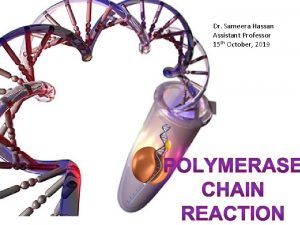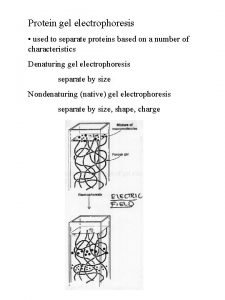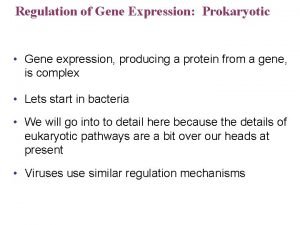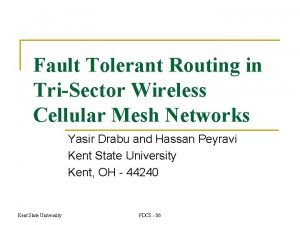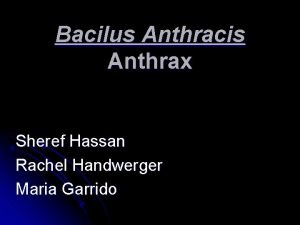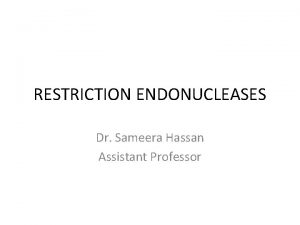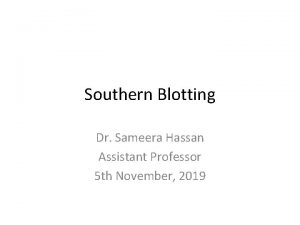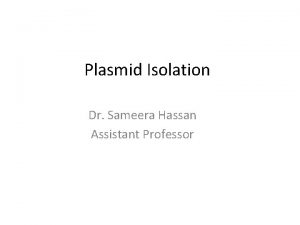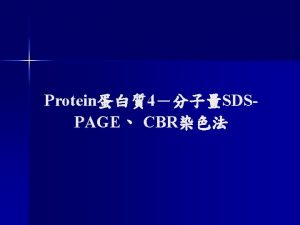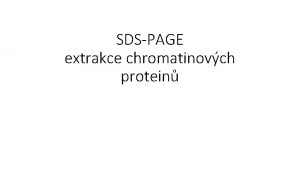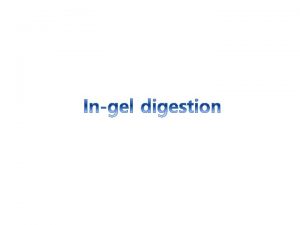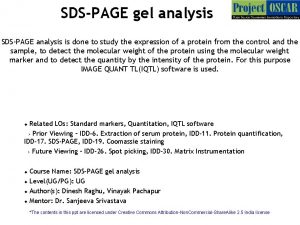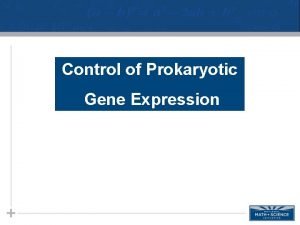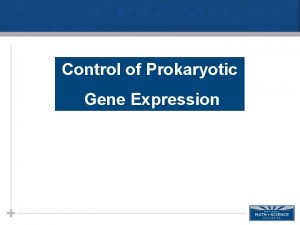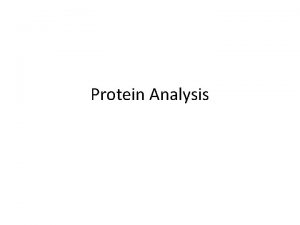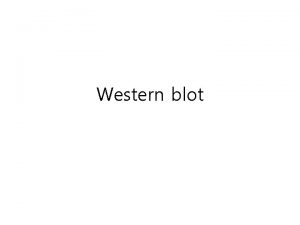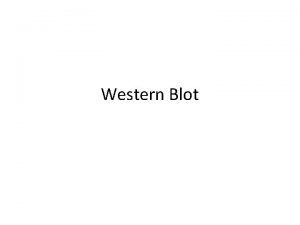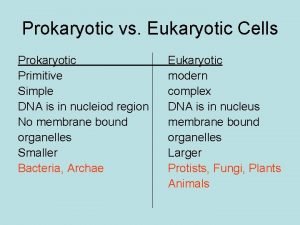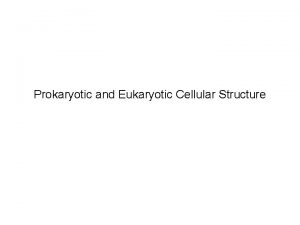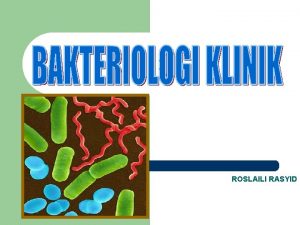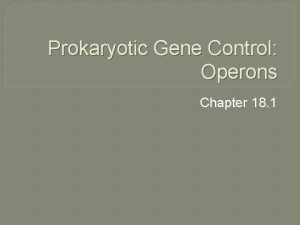Prokaryotic Expression SDSPAGE Western Dr Sameera Hassan Assistant























- Slides: 23

Prokaryotic Expression, SDS-PAGE & Western Dr. Sameera Hassan Assistant Professor


• host E. coli strains containing a chromosomal copy of the gene for T 7 RNA polymerase. • DE 3: DNA fragment containing the lac. I gene, the lac. UV 5 promoter, and the gene for T 7 RNA polymerase. • Once a DE 3 lysogen is formed, the only promoter known to direct transcription of the T 7 RNA polymerase gene is the lac. UV 5 promoter, which is inducible by isopropyl-β-Dthiogalactopyranoside (IPTG) which in turn transcribes the target DNA in the plasmid.


Protein Electrophoresis • Separate proteins based on – Size (Molecular Weight - MW) • Allows us to – characterize – quantify – determine purity of sample – compare proteins from different sources • And it is a step in Western blot

Procedure • • • Prepare polyacrylamide gels Add diluted samples to the sample buffer Heat to 95 C for 4 minutes Load the samples onto polyacrylamide gel Run at 200 volts for 30 -40 minutes Stain

Acrylamide • Acrylamide is a neurotoxin. • The acrylamide concentration of the gel can a be varied, generally in the range from 5% to 25%.


Polymerization of acrylamide n n Cross-linked polyacrylamide gels are formed from the polymerisation of acrylamide monomer in the presence of smaller amounts of N, N’methylenebisacrylamide (bis -acrylamide) Bisacrylamide is the most frequently used cross linking agent for polyacrylamide gels Temed

Vertical Gel Format: Polyacrylamide Gel Electrophoresis Reservoir/Tank Power Supply Glass Plates, Spacers, and Combs

Gel Preparation Reagent 10% (Running Gel) 5% (Stacking Gel) Acrylamide/ Bisacrylamide (40%) * 5. 0 mls 2. 5 mls 1 M Tris-HCl 7. 5 mls Distilled water 7. 2 mls 9. 7 mls 10% SDS 200 µl 10% Ammonium Persulfate 100 µl TEMED (added last) 10 µl * = 29: 1 w: w ratio of acrylamide to N, N'-methylene bis-acrylamide


Criteria for a good gel straight spacers, top, bottom of separating gel parallel, straight wells, appropriate depth of stacking gel.

• A typical mini-gel well holds 10 µl easily, and perhaps 20 µl • To completely denature the samples we heat them in a steaming water bath for at least 10 minutes.

Loading Samples & Running the gel • Run at 200 volts for 30 -40 minutes • Running Buffer, p. H 8. 3 Tris Base 12. 0 g Glycine 57. 6 g SDS 4. 0 g distilled water to 4 liter

• When the dye front is nearly at the bottom of the gel it is time to stop the run.

• commonly used stain for detecting proteins in polyacrylamide gels is 0. 1% Coomassie Blue dye in 50% methanol, 10% glacial acetic acid. • Detection limit is 50 ng protein band • The dye actually penetrates the entire gel, however it only sticks permanently to the proteins. • Excess dye is washed out by 'destaining' with acetic acid/methanol, also with agitation.

• Properly stained/destained gels display a pattern of blue protein bands against a clear background. • The gels can be dried down or photographed for later analysis and documentation.

Blocking • Blocking is a very important step in the immunodetection phase of Western blotting because it prevents non-specific binding of antibody to the blotting membrane • The most commonly used blocking solutions contain 3 -5% BSA or non-fat dried milk in a solution of PBS (phosphate buffered saline) or TBS (tris buffered saline) • Often, a small amount of Tween 20 detergent is added to blocking and washing solutions to reduce background staining, and the buffer is known as PBST or TBST

Antibody Probing • Once the protein samples are separated and transferred onto a membrane, the protein of interest is detected and localized using a specific antibody • The blot will be incubated in a dilute solution of antibody, usually for a few hours at room temperature or overnight at 4°C • The antibody is diluted in wash buffer (PBST or TBST) or in the blocking solution, the choice depends upon the antibody • Since antibody preparations vary in their levels of purity and specific binding properties, there will be differences in the level of dilution required • The manufacturer’s datasheet should provide dilution recommendations for a particular preparation

Antibody Probing • Usually, Western blotting protocols utilize a non-labeled primary antibody directed against the target protein • Wash the membrane several times in TBST while agitating, 5 minutes or more per wash, to remove residual primary antibody • A species-specific, labeled secondary antibody directed against the constant region of the primary antibody is then used • The secondary antibody serves not only as a carrier of the label but is also a mechanism to amplify the emitted signals, as many secondary antibodies can theoretically bind simultaneously to the primary antibody • Secondary Ab is also diluted according to the manufacturer’s recommendations and incubated for 1 hour at RT

6 - Detection with Substrate • The most common antibody label used in Western blots is AP, a small, stable enzyme with high specificity and rapid turnover • The signal is detected when HRP is exposed to a substrate solution in the final step of the immunodetection procedure • Substrate solutions for Western blotting are chemical reagents that are acted upon by the enzyme to yield a signal that can be easily measured

 Sameera hassan
Sameera hassan Sdspage gel
Sdspage gel Sameera siddiqui
Sameera siddiqui Poltrp
Poltrp Linear term
Linear term Dr brendon aubrey
Dr brendon aubrey Bad writing examples
Bad writing examples Affine cipher
Affine cipher Dr nada hassan syed
Dr nada hassan syed Ent université hassan 2
Ent université hassan 2 Hassan tout
Hassan tout Triploblasts
Triploblasts Theme of sacrifice
Theme of sacrifice Dr hassan abdalla
Dr hassan abdalla Hassan chafi oracle
Hassan chafi oracle Mohsen hassan
Mohsen hassan Yasir drabu
Yasir drabu Waheed ul hassan
Waheed ul hassan Fatima el hassan
Fatima el hassan Comparati baladele pasa hassan
Comparati baladele pasa hassan Ayaz ul hassan
Ayaz ul hassan Khaled hosseini hassan
Khaled hosseini hassan Hidrocele y varicocele
Hidrocele y varicocele Dr sheref hassan
Dr sheref hassan
